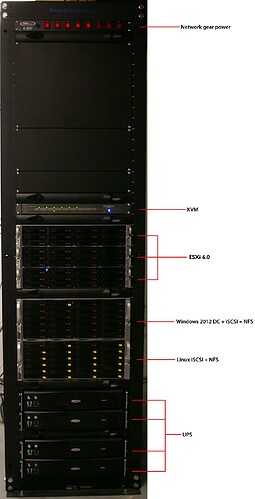Hi,
I’m close to having to increase my storage again and the next increase is going to pretty much use up the capability of my setup. I’m looking for some suggestions on where to go from here.
My server is an old i3 with Arch Linux installed. Connected to it I have a Mediasonic 8 bay enclosure using the USB 3.0 interface (I had a lot of problems with eSATA, but USB3.0 has had zero issues). This is my second enclosure. I had a Sans Digital before that was a disaster, the Mediasonic has been flawless.
I’m using 6 of the 8 enclosures with a mix of 4TB and 6TB HGST NAS drives. I use Snapraid and I have 5 data drives and one parity drive. Snapraid is already complaining that with 5 data drives I should have 2 parity drives, so the next storage increase means adding two 6TB drive, one would be a data drive and the other would be parity.
Long story short, I can only increase my storage by 6TB before filling up my enclosure. Suggestions on what to consider next?
It really depends on how much you want to spend, and how much you think your storage requirements will increase.
Since the Mediasonic enclosure works well for you, I’d say stick with that. If you want long-term future-proofing, get another 8-bay and eight drives of at least 6TB (8TB might be better). Set up those disks using Snapraid and then move all the data from your existing enclosure to the new one. After that, you can do whatever you want with the old enclosure and drives…keep it for backup space, replace the drives with bigger ones, sell it, etc. This sort of big spending now pays off in the long run.
On the other hand, you could get a 4-bay Mediasonic with 8TB drives. This still might allow you to move all your data to the new disks then have the 8-bay to play with. I wouldn’t recommend 10TB drives with just one parity drive…if you lose a drive, the rebuild time would be long enough to be dangerous.
When I built my setup, I went with the first style option (spend big now) and have 84 total bays, with only half of them filled. I mostly only use 2TB and 3TB drives, though, as I can get them used really cheap, and most still have 2-3 years left on their 5-year warranty.
Thanks! What type of enclosure do you use?
I don’t use add-on enclosures…I have rack-mount server cases:
What’s the failure rate been like on those used drives?
Sam
I have two styles of drive. The first are 2TB WD RE SATA drives that were used hard (in Backblaze-style dense pack, where the temperature stays pretty high) for 3 years. Of around 80 of these drives, I’ve lost 10 over 3 years, with one loss about a month ago being the first one out of warranty. From the same source, other people have reported similar failure rates on another 100 or so drives.
The second are 3TB WD enterprise SAS drives, and I only have 16 of them. One was DOA from the seller (controller didn’t recognize it), and was replaced by them. No failures other than that, and all are still under warranty.
The key is finding smaller drives that are being replaced for size reasons, and not age. So, look for 4TB and below, with a 5 year original warranty. Do not get “OEM” drives (i.e., HP, Dell, etc., labeled), as they have no warranty from the original drive manufacturer, and the company on the label only warranties the original purchase. For example, WD doesn’t care if you are the original owner for any WD labeled drive, and the warranty is from date of manufacture, but a WD drive re-labeled by HP isn’t covered.
1 Like
That’s interesting. I had a few Seagate disks fail, but never returned them within warranty. I figured I’d receive refurbished parts and at that point didn’t have much faith in Segate anyway.
Sam
On disks with a 5-year warranty, it’s not uncommon for the vendor to no longer make the exact drive you RMA. That often means they don’t even have any refurbs in stock, so you get new stock of the latest corresponding model.
I haven’t had any issues with the replacement drives that have been by WD, and they are still under warranty to at least the same date as the drive they replaced.
1 Like
A bit off topic story about WD drives. When I used to work for Bell Labs, we used mainly Seagate drives. There was a push to start using more WD drives since they were a nearby company (both in Colorado) so get got a bunch of WD drives. Mainly they were using in PC servers running NT.
After a year or so, we started noticing that the WD drives seemed to fail more often than the Seagate drives. All were replaced under warranty, but in a computer center you care more about failure rates, so we stopped getting new WD drives.
Fast Forward about 3 year and the original batch of drives were out of warranty. We suddenly started have huge failure rates, like probably 25-30%. WD was contacted and they asked for the failed (out of warranty) drives back.
They got back to us and admitted that they discovered there was a problem during the manufacturing of the drives. The platters were not properly rinsed, so some microscopic amounts of soap scum were left on the platters. Over the years the scum built up on the heads eventually causing the drive failures.
They replaced every out of warranty failed drive free of cost, and also every other still working drive from that batch!
My drives are all currently WD 

